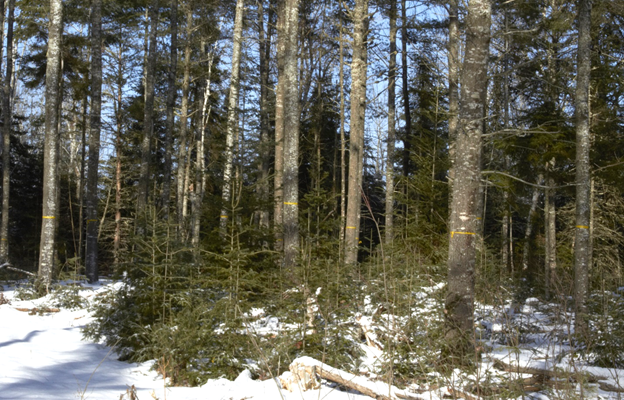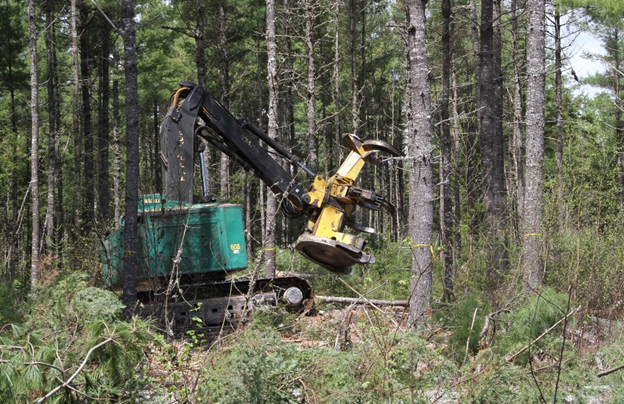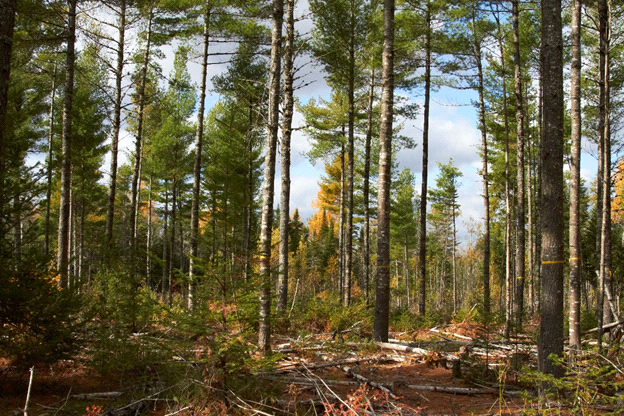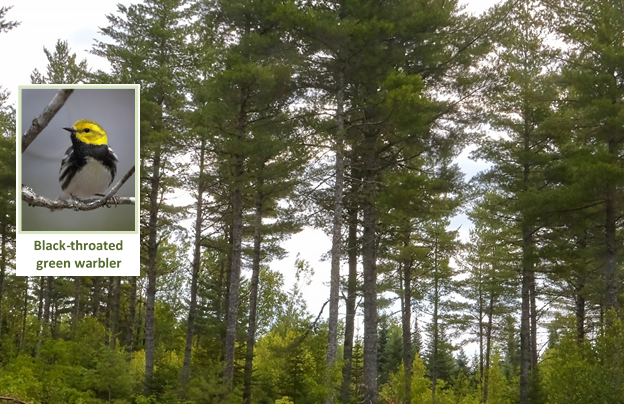DACF Home → Bureaus & Programs → Maine Forest Service → Projects → What will my woods look like? → Thinning and Crown Release of Crop Trees: Natural white pine sawlog stand
Thinning and Crown Release of Crop Trees
Site: Natural white pine sawlog stand
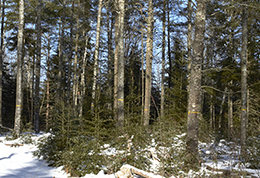
Woodland Owners’ View
These are too many big pines here. Some need to come down so that the others can grow better. There is a lot of unwanted fir here but if the stand is thinned, a few years from now more pine seeds will come.
Logger’s View
There is good road access to this stand, and the trees have sufficient volume and value to make a viable partial cut. Seeing the ribbons on the trees to leave will make it more efficient for the operator. Since the younger fir are not desirable to save, there will be plenty of room for grapple skidders to maneuver without damaging the trees to keep.
Forester’s View
This medium sawtimber-sized white pine stand is too dense; crowns are closed in and the stand is not achieving optimum growth. The established but suppressed fir understory is not a good replacement. Recommend thinning to release the crowns of the best crop trees on three or four sides. Then let the stand grow for a while, as long as the dominant timber trees continue to add volume and value. When the time comes to regenerate the stand, harvesting within a year of a good cone crop should increase the amount of white pine in the next forest.
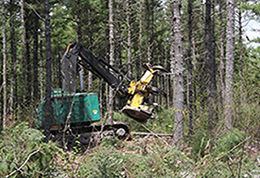
Woodland Owners’ View
The feller buncher has a saw at the bottom of the yellow metal part. It’s like a huge sawmill blade. The operator cuts a tree using the saw, then uses the grips on the front to put it closer to the feller buncher. After enough logs are on that space, the operator moves them to a pile of logs which a skidder then takes to a log yard.
Logger's View
Modern mechanical harvesting equipment allows well-trained operators to see what they are doing, and make good decisions as they cut the designated trees. Boom-mounted saw heads like this reduce the equipment impact by reaching out without driving to the stem that’s being cut.
Equipment Used
Tracked feller buncher, grapple skidder, and loader/slasher on landing.
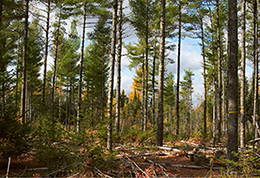
Woodland Owners’ View
The trees are spaced wide apart and wind or insect disease could be a problem in the future. In addition, the width of each tree is small in terms of how strong each tree might be if a big wind came through. On the other hand, each tree now has a lot of light and the crowns can get wider quickly. It is a risk to do wide spacing but it might help in the future growth of the trees.
Forester’s View
Residual stand is in great shape as far as mechanical damage from equipment is concerned. The basal area may be a little below the optimum stocking table guideline; however, the stand is still intact and growth should take off. Should keep an eye out for disease or insect damage. The stand may be susceptible to wind damage for a few years, but these dominant trees have already adapted to wind stress over the years. Unless some unforeseen damaging factor comes into play, grow these trees to a target financial maturity size, perhaps 24” dbh or greater.
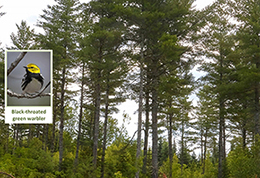
Woodland Owners’ View
The pines are growing bigger crowns and wind has not taken any trees down. There are a lot of new saplings under the pines which include balsam, spruce, red pine, and white pine. While it was a risk, the trees are happy with their sunlight.
Forester’s View
It is amazing how quickly healthy pine respond to more sunlight. These crowns have really expanded in only five years, and the stand has held up during some pretty strong wind events. The understory regeneration, while not part of the original plan, is a welcome hedge, in case it becomes necessary to remove the overstory. But for now, let it grow.
Wildlife Outcome
This stand now has two well established vertical layers, below 6‘and above 30’. Over time, the mid-story layer (6-30’) can become established, which will attract birds such as the black-throated green warblers.
Location:
Wells Demonstration Tree Farm, Milford and Greenfield
Pam and Bryan Wells
http://wellsforest.com/
pwells@oakleafs.com
